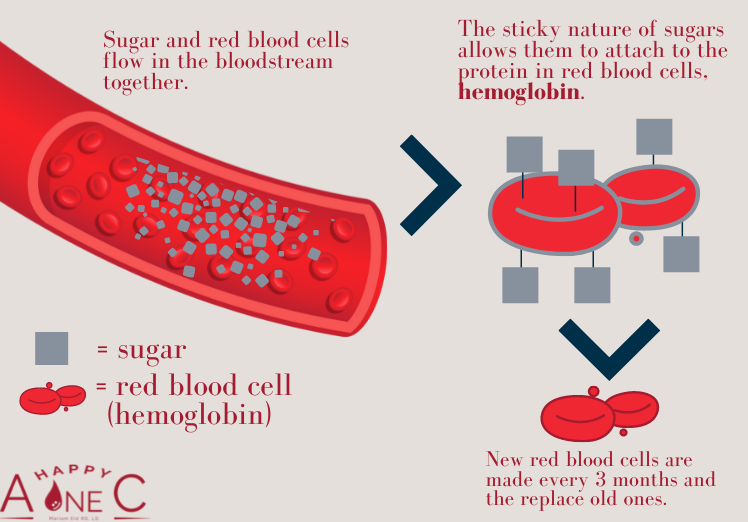What Does the A1C Test Represent?
The A1C test, hemoglobin A1C, HbA1c, glycated hemoglobin, or glycohemoglobin test is the golden standard for representation of blood sugar management over the past 3-4 months. Hemoglobin is the protein molecule of red blood cells that provides the cell with its structure and shape. Hemoglobin also gives red blood cells their characteristic red color. Red blood cells makeup the chemistry of our blood and have about a 3 month lifecycle. That’s why your healthcare provider will likely recommend checking your A1C every three months to check if progress has been made. Hemoglobin carries the oxygen we breathe in and delivers it to each individual cell in our bodies.

Our bodies require our blood highway system to have a certain amount of sugar or glucose concentrated in it to keep us alive. The sticky nature of sugar (i.e. glucose) allows it to attach to hemoglobin structures and remain there for the life cycle of that red blood cell. The A1C test is based on this attachment and is measured as the percentage (%) of the hemoglobin molecule that is connected to a sugar molecules. The more sugars hanging out in your blood, the greater the percent of sugars stuck onto hemoglobin and the higher the A1C reading.
What Interferes with an A1c Reading?
Pregnancy and anemia are major confounders that can lead to misreported A1C values. The physiological changes that occur during the earlier weeks of a non-diabetic pregnancy may underrepresent the A1C value. In the first and second trimesters of pregnancy, the body is working hard to increase the blood supply to deliver nutrients to the baby via the blood. More blood circulating equals more red blood cell turnover, leading to a falsely low A1C reading.
‘Red blood cell turnover’ refers to replacing old red blood cells with new red blood cells to meet the increased demand for these cells. The increase in red blood cell turnover also occurs with blood transfusions, chronic kidney disease, and end-stage liver disease. These may all lead to a falsely low A1C representation.
The changes in the 3rd trimester may lead to a higher value. The mother naturally becomes more resistant to insulin to deliver carbohydrates to the fetus more effectively. If you’re someone with a family history of gestational diabetes, I highly encourage you to seek out a dietitian specializing in gestational diabetes.

The A1C value may be falsely elevated in people with iron-deficiency or vitamin B-12 deficiency anemia. If you’re someone who follows or has a history of following a vegan or vegetarian diet, you may be at risk for anemia. Consult with your healthcare provide to test your iron and B-12 stores. The proposed explanation is that since iron is a primary component of the hemoglobin structure, sugars can replace some of the iron molecules when a deficit in iron is present. As a result, the sugars fill in the spaces iron was supposed to be and the hemoglobin structure ends up more concentrated in sugar. After correcting the deficiency, it’s best to wait until new red blood cells are made to receive an accurate A1C value.
The A1C test may be unreliable for people of African, Mediterranean, or Southeast Asian descent or people who have family members with sickle cell anemia or thalassemia. These populations have a hemoglobin mutation and require further evaluation by their healthcare provider. The data collected by the American Diabetes Association show that all non-white racial and ethnic groups have slightly higher “normal” A1C levels than white people. The difference in A1C levels among ethnic groups comes down to biology, not necessarily blood sugar control.
Interpreting Your a1c
As discussed above, the A1C test represents the average amount of sugar present in the blood within the past three months. Based on your A1C, you can estimate your average blood sugar during the past 3 months.
A higher A1C value = higher blood sugar levels. The following outlines the estimated blood sugar reading associated with A1C values.
- A normal A1C reading is less than 5.7%. This corresponds to an estimated average blood sugar reading that is less than 117 mg/dl.
- A pre-diabetic A1C reading is between 5.7% and 6.4%. This corresponds to an estimated average blood sugar reading of 117-137 mg/dl.
- A diabetic A1C reading is above 6.5%. This corresponds to an estimated average blood sugar reading that is greater than 137 mg/dl.

What Does "Blood sugar" mean?

“Blood sugar” refers to the amount of sugar in your blood stream at a give time. A higher A1C value indicates high blood sugar levels. Unlike an A1C test, which must be performed in a lab, you can test your blood sugar levels at home using the finger-prick method, i.e., Glucometer. The target blood sugar range varies depending on whether you just woke up and how long ago you had a meal or snack. According to the American Diabetes Association, a non-diabetic adult should follow the following target blood sugar ranges outlined below:
- Morning “fasting” blood sugar, or a blood sugar reading taken 4 hours after a meal or snack = 70 to 99 mg/dl.
- Blood sugar reading taken 1 hour after eating = 90 to 130 mg/dl.
- Blood sugar reading taken 2 hours after eating = 90 to 110 mg/dl..
In addition to an A1C between 5.7 and 6.4, you may also be at risk of pre-diabetes if you have a fasting blood sugar between 100-125 mg/dl. Please consult with your healthcare provider to check or recheck your A1C level.
References:
1) American Diabetes Association. 6. Glycemic targets: Standards of Medical Care in Diabetes—2018. Diabetes Care. 2018;41(suppl 1):S55–S64.
2) “The A1C Test & Diabetes.” National Institute of Diabetes and Digestive and Kidney Diseases, U.S. Department of Health and Human Services, May 2018, https://www.niddk.nih.gov/health-information/diagnostic-tests/a1c-test.

Hi, this is a comment.
To get started with moderating, editing, and deleting comments, please visit the Comments screen in the dashboard.
Commenter avatars come from Gravatar.